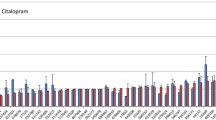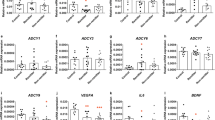Abstract
Adverse drug reactions (ADRs) are a major concern in pharmacotherapy and are more common among women. Immortalized human lymphoblastoid cell lines (LCLs) are emerging as a novel tool for studying interindividual variability in drug response, including ADRs. In the present study, we compared sensitivities of LCLs from unrelated healthy male and female donors to growth inhibition by a panel of common drugs. We observed large interindividual drug sensitivity variations with similar mean sensitivities recorded for LCLs from male and female donors for most tested drugs. A notable exception was observed for the typical antipsychotic haloperidol and the atypical antipsychotic risperidone, which exhibited, on average, more robust in vitro growth inhibition in male as compared with female LCLs. An opposite finding was observed for the antidepressant paroxetine, which was more potent for inhibiting the growth of female as compared with male LCLs. These observations are discussed in the context of the higher incidence of dystonia reported for male schizophrenia patients treated with haloperidol and the higher efficacy of paroxetine in female major depression patients.
Similar content being viewed by others
References
Abel KM, Drake R, Goldstein JM (2010) Sex differences in schizophrenia. Int Rev Psychiatry 22:417–428
Addonizio G, Alexopoulos GS (1988) Drug-induced dystonia in young and elderly patients. Am J Psychiatry 145:869–871
Aguilar EJ, Keshavan MS, Martinez-Quiles MD, Hernandez J, Gomez-Beneyto M, Schooler NR (1994) Predictors of acute dystonia in first-episode psychotic patients. Am J Psychiatry 151:1819–1821
Budnitz DS, Pollock DA, Weidenbach KN, Mendelsohn AB, Schroeder TJ, Annest JL (2006) National surveillance of emergency department visits for outpatient adverse drug events. JAMA 296:1858–1866
Clark SL, Adkins DE, Aberg K, Hettema JM, McClay JL, Souza RP, van den Oord EJ (2011) Pharmacogenomic study of side-effects for antidepressant treatment options in STAR*D. Psychol Med 1:1–12 [Epub ahead of print]
Domecq C, Naranjo CA, Ruiz I, Busto U (1980) Sex-related variations in the frequency and characteristics of adverse drug reactions. Int J Clin Pharmacol Ther Toxicol 18:362–366
Giegling I, Drago A, Schäfer M, Möller HJ, Rujescu D, Serretti A (2011) Sociodemographic and treatment related variables are poor predictors of haloperidol induced motor side effects. Prog Neuropsychopharmacol Biol Psychiatry 35:74–77
Gurwitz D, Kimchi O, Bonne-Tamir B (2003) The Israeli DNA and cell line collection: a human diversity repository. In: Knoopers BM (ed) Populations and genetics: legal and socio-ethical perspectives. Martinus Nijhopp, Leiden, pp 95–113
Klein U, Klein M, Sturm H, Rothenbühler M, Huber R, Stucki P, Gikalov I, Keller M, Hoigné R (1976) The frequency of adverse drug reactions as dependent upon age, sex and duration of hospitalization. Int J Clin Pharmacol Biopharm 13:187–195
Moleman P, Schmitz PJ, Ladee GA (1982) Extrapyramidal side effects and oral haloperidol: an analysis of explanatory patient and treatment characteristics. J Clin Psychiatry 43:492–496
Morag A, Kirchheiner J, Rehavi M, Gurwitz D (2010) Human lymphoblastoid cell line panels: novel tools for assessing shared drug pathways. Pharmacogenomics 11:327–340
Morag A, Pasmanik-Chor M, Oron-Karni V, Rehavi M, Stingl JC, Gurwitz D (2011) Genome-wide expression profiling of human lymphoblastoid cell lines identifies CHL1 as a putative SSRI antidepressant response biomarker. Pharmacogenomics 12:171–184
Pirmohamed M, James S, Meakin S, Green C, Scott AK, Walley TJ, Farrar K, Park BK, Breckenridge AM (2004) Adverse drug reactions as cause of admission to hospital: prospective analysis of 18,820 patients. BMJ 329:15–19
Prommer E (2012) Role of haloperidol in palliative medicine: an update. Am J Hosp Palliat Care 29:295–301 [Epub 2011 Oct 13]
Rodenburg EM, Stricker BH, Visser LE (2011) Sex-related differences in hospital admissions attributed to adverse drug reactions in the Netherlands. Br J Clin Pharmacol 71:95–104
Rubin LH, Haas GL, Keshavan MS, Sweeney JA, Maki PM (2008) Sex difference in cognitive response to antipsychotic treatment in first episode schizophrenia. Neuropsychopharmacology 33:290–297
Serretti A, Gibiino S, Drago A (2011) Specificity profile of paroxetine in major depressive disorder: meta-regression of double-blind, randomized clinical trials. J Affect Disord 132:14–25
Stark AL, Zhang W, Mi S, Duan S, O'Donnell PH, Huang RS, Dolan ME (2010) Heritable and non-genetic factors as variables of pharmacologic phenotypes in lymphoblastoid cell lines. Pharmacogenomics J 10:505–512
Swett C Jr (1975) Drug-induced dystonia. Am J Psychiatry 132:532–534
Welsh M, Mangravite L, Medina MW, Tantisira K, Zhang W, Huang RS, McLeod H, Dolan ME (2009) Pharmacogenomic discovery using cell-based models. Pharmacol Rev 61:413–429
Wheeler HE, Dolan ME (2012) Lymphoblastoid cell lines in pharmacogenomic discovery and clinical translation. Pharmacogenomics 13:55–70
Wonodi I, Adami HM, Cassady SL, Sherr JD, Avila MT, Thaker GK (2004) Ethnicity and the course of tardive dyskinesia in outpatients presenting to the motor disorders clinic at the Maryland psychiatric research center. J Clin Psychopharmacol 24:592–598
Zhang W, Huang RS, Duan S, Dolan ME (2009) Gene set enrichment analyses revealed differences in gene expression patterns between males and females. In Silico Biol 9:55–63
Acknowledgments
We thank the anonymous donors of the NLGIP biobank at Tel Aviv University, Israel, whose altruism and trust in biomedical research have made this study possible. This study was supported by the Chief Scientist Office, Ministry of Health, Israel, in the frame of ERA-Net Neuron.
Author information
Authors and Affiliations
Corresponding author
Rights and permissions
About this article
Cite this article
Morag, A., Oved, K. & Gurwitz, D. Sex Differences in Human Lymphoblastoid Cells Sensitivities to Antipsychotic Drugs. J Mol Neurosci 49, 554–558 (2013). https://doi.org/10.1007/s12031-012-9852-z
Received:
Accepted:
Published:
Issue Date:
DOI: https://doi.org/10.1007/s12031-012-9852-z




